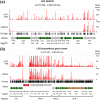A Comprehensive Overview of the Genes and Functions Required for Lettuce Infection by the Hemibiotrophic Phytopathogen Xanthomonas hortorum pv. vitians
- PMID: 35311560
- PMCID: PMC9040725
- DOI: 10.1128/msystems.01290-21
A Comprehensive Overview of the Genes and Functions Required for Lettuce Infection by the Hemibiotrophic Phytopathogen Xanthomonas hortorum pv. vitians
Abstract
The successful infection of a host plant by a phytopathogenic bacterium depends on a finely tuned molecular cross talk between the two partners. Thanks to transposon insertion sequencing techniques (Tn-seq), whole genomes can now be assessed to determine which genes are important for the fitness of several plant-associated bacteria in planta. Despite its agricultural relevance, the dynamic molecular interaction established between the foliar hemibiotrophic phytopathogen Xanthomonas hortorum pv. vitians and its host, lettuce (Lactuca sativa), remains completely unknown. To decipher the genes and functions mobilized by the pathogen throughout the infection process, we conducted a Tn-seq experiment in lettuce leaves to mimic the selective pressure occurring during natural infection. This genome-wide screening identified 170 genes whose disruption caused serious fitness defects in lettuce. A thorough examination of these genes using comparative genomics and gene set enrichment analyses highlighted that several functions and pathways were highly critical for the pathogen's survival. Numerous genes involved in amino acid, nucleic acid, and exopolysaccharide biosynthesis were critical. The xps type II secretion system operon, a few TonB-dependent transporters involved in carbohydrate or siderophore scavenging, and multiple genes of the carbohydrate catabolism pathways were also critical, emphasizing the importance of nutrition systems in a nutrient-limited environment. Finally, several genes implied in camouflage from the plant immune system and resistance to immunity-induced oxidative stress were strongly involved in host colonization. As a whole, these results highlight some of the central metabolic pathways and cellular functions critical for Xanthomonas host adaptation and pathogenesis. IMPORTANCE Xanthomonas hortorum was recently the subject of renewed interest, as several studies highlighted that its members were responsible for diseases in a wide range of plant species, including crops of agricultural relevance (e.g., tomato and carrot). Among X. hortorum variants, X. hortorum pv. vitians is a reemerging foliar hemibiotrophic phytopathogen responsible for severe outbreaks of bacterial leaf spot of lettuce all around the world. Despite recent findings, sustainable and practical means of disease control remain to be developed. Understanding the host-pathogen interaction from a molecular perspective is crucial to support these efforts. The genes and functions mobilized by X. hortorum pv. vitians during its interaction with lettuce had never been investigated. Our study sheds light on these processes by screening the whole pathogen genome for genes critical for its fitness during the infection process, using transposon insertion sequencing and comparative genomics.
Keywords: Tn-seq; Xanthomonas hortorum; comparative genomics; lettuce; phytopathogen.
Conflict of interest statement
The authors declare no conflict of interest.
Figures




Similar articles
-
In vitro exploration of the Xanthomonas hortorum pv. vitians genome using transposon insertion sequencing and comparative genomics to discriminate between core and contextual essential genes.Microb Genom. 2019 Sep;7(6):000546. doi: 10.1099/mgen.0.000546. Microb Genom. 2019. PMID: 33760724 Free PMC article.
-
Differential Sources of Resistance from Lactuca serriola Against Three Races of Xanthomonas hortorum pv. vitians Causing Bacterial Leaf Spot of Lettuce.Plant Dis. 2025 Mar;109(3):615-622. doi: 10.1094/PDIS-06-24-1239-RE. Epub 2025 Mar 14. Plant Dis. 2025. PMID: 39352509
-
Clarifying the taxonomy of the causal agent of bacterial leaf spot of lettuce through a polyphasic approach reveals that Xanthomonas cynarae Trébaol et al. 2000 emend. Timilsina et al. 2019 is a later heterotypic synonym of Xanthomonas hortorum Vauterin et al. 1995.Syst Appl Microbiol. 2020 Jul;43(4):126087. doi: 10.1016/j.syapm.2020.126087. Epub 2020 May 23. Syst Appl Microbiol. 2020. PMID: 32690196
-
Xanthomonas hortorum - beyond gardens: Current taxonomy, genomics, and virulence repertoires.Mol Plant Pathol. 2022 May;23(5):597-621. doi: 10.1111/mpp.13185. Epub 2022 Jan 23. Mol Plant Pathol. 2022. PMID: 35068051 Free PMC article.
-
Genetic and structural determinants on iron assimilation pathways in the plant pathogen Xanthomonas citri subsp. citri and Xanthomonas sp.Braz J Microbiol. 2020 Sep;51(3):1219-1231. doi: 10.1007/s42770-019-00207-x. Epub 2020 Aug 28. Braz J Microbiol. 2020. PMID: 31848911 Free PMC article. Review.
Cited by
-
Shedding light on bacteria-host interactions with the aid of TnSeq approaches.mBio. 2024 Jun 12;15(6):e0039024. doi: 10.1128/mbio.00390-24. Epub 2024 May 9. mBio. 2024. PMID: 38722161 Free PMC article. Review.
-
Xanthomonas spp. Infecting Araceae and Araliaceae: Taxonomy, Phylogeny, and Potential Virulence Mechanisms.Biology (Basel). 2025 Jun 25;14(7):766. doi: 10.3390/biology14070766. Biology (Basel). 2025. PMID: 40723327 Free PMC article. Review.
-
Harnessing the genomic diversity of Pseudomonas strains against lettuce bacterial pathogens.Front Microbiol. 2022 Dec 22;13:1038888. doi: 10.3389/fmicb.2022.1038888. eCollection 2022. Front Microbiol. 2022. PMID: 36620043 Free PMC article.
-
High-Throughput Tn-Seq Screens Identify Both Known and Novel Pseudomonas putida KT2440 Genes Involved in Metal Tolerance.Environ Microbiol. 2025 May;27(5):e70095. doi: 10.1111/1462-2920.70095. Environ Microbiol. 2025. PMID: 40302248 Free PMC article.
-
MicroRNAs Involved in Nutritional Regulation During Plant-Microbe Symbiotic and Pathogenic Interactions with Rice as a Model.Mol Biotechnol. 2024 Aug;66(8):1754-1771. doi: 10.1007/s12033-023-00822-y. Epub 2023 Jul 19. Mol Biotechnol. 2024. PMID: 37468736 Review.
References
-
- Pierella Karlusich JJ, Zurbriggen MD, Shahinnia F, Sonnewald S, Sonnewald U, Hosseini SA, Hajirezaei M-R, Carrillo N. 2017. chloroplast redox status modulates genome-wide plant responses during the non-host interaction of tobacco with the hemibiotrophic bacterium Xanthomonas campestris pv. vesicatoria. Front Plant Sci 8:1158. doi:10.3389/fpls.2017.01158. - DOI - PMC - PubMed
-
- Islam MT, Al Mamun M, Lee B-R, Van Hien L, Jung W-J, Bae D-W, Kim T-H. 2021. Role of salicylic acid signaling in the biotrophy-necrotrophy transition of Xanthomonas campestris pv. campestris infection in Brassica napus. Physiol Mol Plant Pathol 113:101578. doi:10.1016/j.pmpp.2020.101578. - DOI
-
- Luneau JS, Cerutti A, Roux B, Carrère S, Jardinaud M-F, Gaillac A, Gris C, Lauber E, Berthomé R, Arlat M, Boulanger A, Noël LD. 2022. Xanthomonas transcriptome inside cauliflower hydathodes reveals bacterial virulence strategies and physiological adaptations at early infection stages. Mol Plant Pathol 23:159–174. doi:10.1111/mpp.13117. - DOI - PMC - PubMed
Publication types
MeSH terms
Substances
Supplementary concepts
LinkOut - more resources
Full Text Sources
Research Materials

